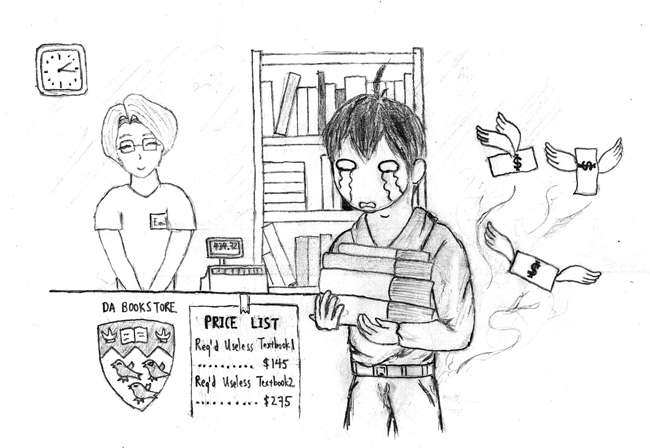A week into my second year at McGill, I was apoplectic. My books for the first semester cost me nearly a thousand dollars—a sum unheard of for an Arts student. The text for my introduction to Chinese culture class, a fairly thin paperback, was nearly $200 alone. Like most students beginning university, I had never had to replace a lost or damaged high school textbook, so walking into a store to buy textbooks was strange to begin with. Sticker shock was inevitable; I’d never been exposed to just how much a book can cost. As I continued my studies here, I adjusted. I noticed myself saying things like, “Wow, I only spent $400 on books this semester!”
The most common target for ire over book prices is the bookstore itself, and understandably so––it’s certainly the easiest. On campus, I often overhear conversations along the lines of: “Books here are so expensive because the bookstore is a private monopoly. Why doesn’t McGill do something about it?” And almost every semester, at least one of my professors has mentioned that the text is at Paragraphe, usually because they’re concerned over the near-monopoly of the McGill bookstore and the high prices that they feel result from it.
In reality, the bookstore is 100 per cent owned and operated by McGill. It was privately managed from 1999 to 2003, but it has never been owned by anybody but the university. Moreover, the monopoly of the bookstore isn’t to blame for book prices—on the contrary, if you break down the price of a book, it actually benefits students.
Roughly 80 per cent of a book’s sticker price goes back to the publisher. The bookstore’s operating costs, such as staff, shipping, and the mortgage on the building, make up another 14 per cent. The remainder is transferred to Student Life and Learning, contributing to financial aid, amongst other things. The bookstore also employs a large number of students at a reasonable wage. The more books the bookstore sells, the more money is available for financial aid, and the more students McGill employs.
So then, seeing as it isn’t the bookstore’s fault, why are books so expensive? Surprisingly the real culprit is used books.
Publishers estimate that taking a book from concept to market costs $750,000. Not only is the content itself expensive, but licensing, design, and editing all have to be paid for before printing. These development costs are averaged out over the sales of the book. Each `additional copy sold reduces the share of these costs—so the more books are sold, the lower the average of development costs, and the lower the price. Sales of used books, on the other hand, don’t offset development costs because they return nothing to the publisher. But because students save money and recoup some of their initial expense, and bookstores have much higher margins on used books, there is huge incentive to buy and sell used copies.
In America, this has resulted in used books making up 40 per cent of the textbook market, reducing the high sales period for a textbook to only two years. The number of copies that have to pay down development costs has declined, and prices have increased as a result. Worryingly, a vicious cycle has begun. As prices increase, used books are more attractive, textbook life spans shorten, and prices increase further. This is partly why new editions come out so often—publishers are trying to increase sales to keep book development affordable.
Of course, there are other things that contribute to high textbook prices. In general, most students will buy the book assigned for the course regardless of price. Instructors usually assign textbooks without thinking about the cost to students, and many don’t even know the price of the book they assign. “Examination copies” given to professors by publishers can make up 10 per cent of the printing run, and obviously don’t help to pay development costs. The publishing market itself is highly consolidated, with little competition, which can also increase prices.
That said, the influence of used books on textbook prices remains large and undeniable. Lowering textbook prices in a way that conserves paper, saves students money, and rewards authors fairly is a complex problem that requires more than pointing fingers at campus bookstores.









This article is factually incorrect. The bookstore was owned for many years jointly by McGill and SSMU, until the 2005-2006 year.
http://ssmu.mcgill.ca/wp-content/uploads/2010/01/ssmu_history-final1-opt.pdf